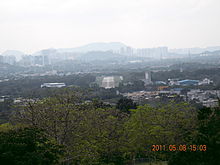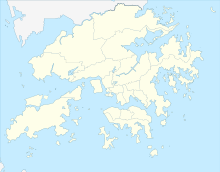The Shek Kong Airfield (ICAO: VHSK), formerly Royal Air Force Sek Kong or Sek Kong Airfield, is an airfield (airbase) located in Shek Kong, New Territories, Hong Kong.
Shek Kong Airfield 石崗機場 | |||||||||||
|---|---|---|---|---|---|---|---|---|---|---|---|
 approach view of Shek Kong Airfield runway | |||||||||||
| Summary | |||||||||||
| Airport type | Military / public | ||||||||||
| Owner | Government of Hong Kong (1997–present) Ministry of Defence (UK) (1938–1997) | ||||||||||
| Operator | PLA Hong Kong Garrison (1997–present) Royal Air Force (1938–1997) | ||||||||||
| Serves | Shek Kong | ||||||||||
| Location | New Territories, Hong Kong | ||||||||||
| Opened | 1950 | ||||||||||
| Built | 1938 | ||||||||||
| Elevation AMSL | 15 m / 50 ft | ||||||||||
| Coordinates | 22°26′11″N 114°4′50″E / 22.43639°N 114.08056°E | ||||||||||
| Map | |||||||||||
 | |||||||||||
| Runways | |||||||||||
| |||||||||||
| Shek Kong Airfield | |||||||||||||
|---|---|---|---|---|---|---|---|---|---|---|---|---|---|
| Traditional Chinese | 石崗機場 | ||||||||||||
| Simplified Chinese | 石岗机场 | ||||||||||||
| |||||||||||||

The base currently houses air force units of People's Liberation Army Hong Kong Garrison (PLAHKG), as well as previously being open for restricted civilian use during weekends.
Royal Air Force history
editThis section needs additional citations for verification. (September 2014) |
Before the British handover of Hong Kong to China in 1997, the airfield was used by the British Forces Overseas Hong Kong, and was then a Royal Air Force station, officially known as Royal Air Force Sek Kong, commonly abbreviated RAF Sek Kong. Construction started in 1938, but ceased from 1941 to 1945 and was completed only in 1950 due to the Japanese occupation of Hong Kong during World War II.
From 1989,[1] to 1993,[2] RAF Sek Kong was also a Vietnamese Refugee Detention Centre.
It is currently used by the People's Liberation Army (PLA) during the week but, during weekends, members of the Hong Kong Aviation Club (HKAC) use to be allowed to use the airport facilities for operation of private aeroplanes and to conduct private flight training.[3][4]
At RAF Sek Kong, the Royal Air Force operated a small force of a single squadron from 1950 to 1996. It was a permanent assignment, with personnel and their families living in Sek Kong for three-year tours of duty. The Royal Hong Kong Auxiliary Air Force (RHK AuxAF) was also a permanent air force unit in Hong Kong.
A partial list of RAF squadrons stationed at RAF Sek Kong before 1997:
- No. 80 Squadron RAF: 3 January – 1 February 1950, 7 March – 28 April 1950
- No. 28 Squadron RAF: 1 May – 7 October 1950, 28 March 1951 – 15 August 1955, 5 December 1955 – 14 June 1957, 17 May 1978 – 1 November 1996
- Royal Hong Kong Auxiliary Air Force 1979–1993
A list of RAF aircraft stationed at RAF Sek Kong:
| builder / model | type | number | dates | operator |
|---|---|---|---|---|
| Supermarine Spitfire F.24 | fighter | 1949–1951 | No. 80 Squadron RAF | |
| de Havilland Vampire | fighter | 1951–1954 | ||
| de Havilland Hornet | fighter | 1951–1955 | No. 80 Squadron RAF | |
| Westland Wessex | helicopter | 1978–1996 | No. 28 Squadron RAF[5] |
With a Vietnamese refugee camp using the runway from 1989[1] to 1993,[2] the base hosted only helicopters after 1989 until the runway was reinstated in 1995. However, no fixed wing aircraft of the RAF used the runway before the base was closed in 1996.[citation needed]
-
RAF Sek Kong 1983
-
Dauphin of RHKAAF
British Army
editThe British Army also operated a squadron of helicopters at RAF Sek Kong from 1970 until 1993, performing observation / reconnaissance and troop-lifting roles on the Hong Kong to mainland Chinese border, and supporting the army on exercises. The Army Air Corps (AAC) unit was heavily involved in stemming the flood of illegal immigrants from mainland China. No. 660 Squadron AAC operated from 1978 until the end of 1993.[6] The AAC squadron, 50 years old at the time, was the last overseas unit using Westland Scout helicopters.[5][7]
- Support equipment
| Manufacturer / Model | Type | Number | Dates | Details |
|---|---|---|---|---|
| Bedford | RL tipper truck | 1980s–1990s | ||
| Later model Thornycroft Antar (pre-1984) and Scammell Commander (post 1984) | tank transporters (tractor and trailer) | 1980s–1990s | By Gurkha Transport Regiment[7] |
Refugee camp, 1989–1993
editFrom 1989, the base was also a refugee centre for Vietnamese boat people arriving in Hong Kong.[1] At the peak in 1992, the centre hosted 9,000 refugees.[2][8] During the time as a refugee centre, half the runway was closed and used for temporary housing (mainly tents, and some quonset huts).[8] As a result, only rotary aircraft operated from the base. The refugee centre closed in 1993 and the runway was restored for use by fixed wing aircraft.
PLAAF base, 1997–present
editThe PLAAF has had a small presence in Hong Kong since 1997. There is one PLA unit stationed in Shek Kong:
| builder / model | type | number | dates | details |
|---|---|---|---|---|
| HAMC Harbin Z-9B | utility helicopters | 12 | 1997–present |
The PLA ground and naval forces also use Shek Kong, mainly for training and Open Day use.
With the PLAAF operating helicopters, the runway is mostly used for civilian fixed wing aircraft. There are four 'H's marked along the runway for the Harbin Z-9Bs to land, and avoided the need to create helipads at the base.
Private use
editWhilst still under Royal Air Force operation, the Hong Kong Aviation Club (HKAC), Hong Kong's private recreational flying organisation,[4] moved most of its aircraft to Shek Kong in 1994. This was after the hours for general aviation (GA) at Kai Tak Airport (then the international airport for Hong Kong) were sharply reduced, to two hours per morning (07:00 to 09:00), as of 1 July that year.[3]
Archaeological discoveries
editAccording to the book: Archaeological discoveries of Guangdong province during Jin dynasty to Tang dynasty, urns tracing back to Tang dynasty ( AD 618--AD 907 ) were discovered in Shek kong airport.
See also
editReferences
edit- ^ a b c Griffin, Kathy; Tam, Bonny (18 June 1989). "Local march to show anger at Viet policy" (PDF). sunzi1.Lib.HKU.hk. South China Morning Post. Archived from the original on 28 May 2008. Retrieved 28 May 2021 – via University of Hong Kong Libraries.
{{cite web}}: CS1 maint: bot: original URL status unknown (link) - ^ a b c Stoddart, Tom (1 January 1989). "Shek Kong Camp - Young Vietnamese refugees at the Shek Kong Airfield in Shek Kong, Hong Kong, 1993". www.GettyImages.co.uk. Tom Stoddart Archive / Hulton Archive / Getty Images. Retrieved 28 May 2021.
- ^ a b Gilbert, Andy (22 August 1994). "Aviation club takes off for Sek Kong". www.SCMP.com. South China Morning Post. Retrieved 28 May 2021.
- ^ a b "High-flyers have licence to thrill". www.SCMP.com. South China Morning Post. 26 June 2010. Retrieved 28 May 2021.
For anyone who has ever dreamt of flying, the first step to getting your wings is to join the Hong Kong Aviation Club (HKAC), the city's only flight training centre.[...] The Shek Kong Airfield is used by the People's Liberation Army during the week, with permission given to the club to use it during weekends.
- ^ a b Clarke, Rachel (15 October 1993). "660 Squadron named as first unit to disband". www.SCMP.com. South China Morning Post. Retrieved 28 May 2021.
- ^ "660 Squadron". British-Army-units1945on.co.uk. British Army units from 1945 on. Retrieved 28 May 2021.
- ^ a b Kneen, J. Michael; Sutton, D. John (1 January 1997). Craftsmen of the Army: The Story of the Royal Electrical and Mechanical Engineers Vol II 1969-1992. Pen & Sword Books Limited. pp. 327, 331–332. ISBN 1473813409. Retrieved 28 May 2021 – via Google Books.
- ^ a b Basler, Barbara (4 February 1992). "18 Vietnamese die in violence at refugee camp". The New York Times. Retrieved 28 May 2021.
